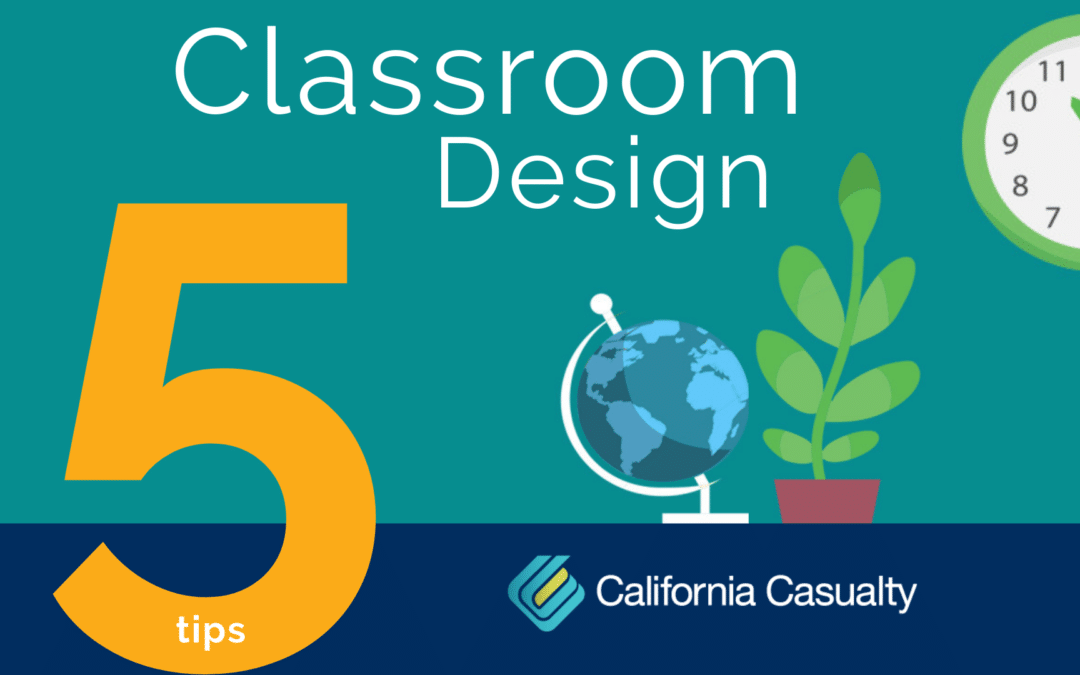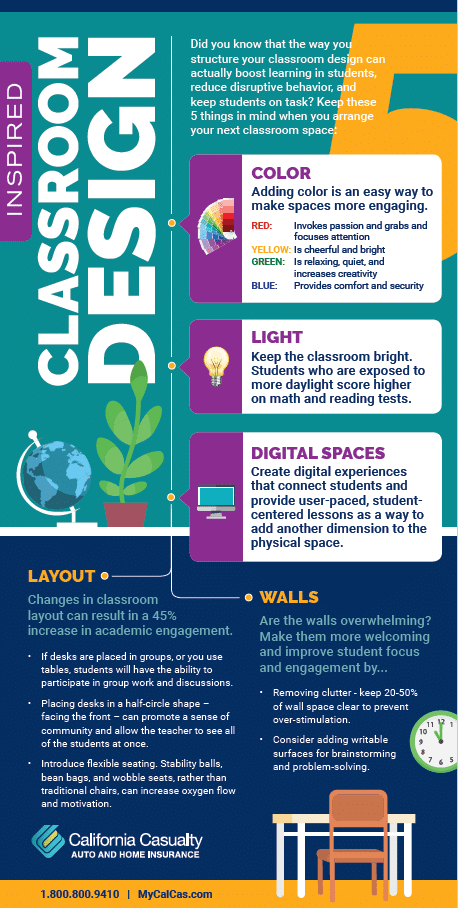It’s August, which means it’s officially back to school season, and many teachers are working hard in their classroom to get it prepared for that first day!
An organized classroom is an integral part of the learning process. Did you know that the way you structure you classroom design can actually boost learning in students, reduce disruptive behavior, and keep them on task? Behavioral problems in children have been linked back to poor color planning and lighting alone! So, keep these 5 classroom design tips in mind when you organize your space this year:
1. Color
White walls are under-stimulating, while too much color causes over-stimulation. The key to “coloring your classroom” is to find balance and make it comfortable. When using color you want something that is conductive to learning, while positively promoting mental and physical well-being.
For Young Children: Use brighter, warm, colors to draw in their focus on whats going on in the classroom instead of outside, like: yellow, red and orange.
For Older Children: Use calming colors that allow the teenagers to focus on their work, and not their surroundings, like: blue, purple, green, and gray.
If you are able to paint your classroom avoid picking colors that are too bright. Instead pick a more muted shade that will not be distracting. And when you have chosen a color palette do not paint the entire room, instead paint a wall or two and leave the rest neutral. If you’re school does not allow you to paint you could always follow the color scheme you like with your decor. Find posters and create bulletin boards around the color theme you like, and buy furniture for your classroom (like chairs, rugs, storage bins, shelves, etc.) that complement that theme.
2. Light
Harsh lighting can cause headaches and disruptive behavior in students, so it is important to find the proper lighting for your classroom. Research shows that with the right lighting student’s test scores even increase! The key is to use as much natural light as you can, or lights that imitate natural light (aka lights with blue undertones). When students are taking tests, the natural feel helps them relax and focus. If you don’t have enough natural light or you prefer to keep the lights off you can fill up your classroom with lamps, hanging lights, or Christmas lights. Just try and avoid yellow undertones because those tend to make students more fatigued.
3. Digital Spaces
Students today are not just learning in the classroom, they are learning in the digital dimension. It is important for teachers to create digital experiences that connect students and provide-user paced, student-centered lessons as a way to add another dimension to the physical space. Providing resources to students digitally helps teachers build relationships with them. So, to help students feel safe in this space teachers must introduce it, establish rules and norms, and visit it frequently.
STEPS:
- Choose an online system that best suites you and your class
- Create an account and add your students
- Create activities and set aside a specific time for those activities
- Never stop exploring what’s new
Whether you have one online activity, or many, that you do with your students, you should have a spot in your classroom where online activity is represented. Consider a discussion board, or a table that you gather around to view. OR set aside time in the day/week that you do activities on a SMART board or computer together and create in-person activities that go along with them!
4. Layout
Classroom layout can result in a 45% increase in academic engagement. Desk arrangement all comes down to how much space you have, what you think would work best for your class, and how they learn. You could set your students in a:
- Standard spaced out arrangement
- Angled rows
- Modified U or Horseshoe
- Groups
- Combination
Or choose one layout and then mix it up every quarter!
Another option is flexible seating for students. Flexible seating is student-centered and ditches the idea of a regular desk. Instead it focuses on a variety of different seating options varying from stools, bean bags, rockers, stability balls, couches, padded storage bins, pillows, etc. Students love it because they are not just stuck in a regular desk. They will have more mobility and can be more comfortable. As long as your students are happy and it boosts learning, the possibilities are endless!
5. Walls
The walls in your classroom should be fun and conducive to learning! So when you are decorating them, ask yourself from the student’s perspective, “Is this overwhelming?” A great idea that you have in your head or saw on Pinterest may have too much print or be too harshly colored for your students depending on their age. You should keep at least 20-50% of your walls clear to prevention over stimulation. However that doesn’t mean you can’t have fun with it!
You can fill your walls with positive messages, student crafts, and learning materials, but it is also recommended to have at least one wall set aside for student engagement. Something the students can go to everyday and find resources, learn new words/facts, interact with each other, or turn in their work.
If you are having trouble finding ideas for your classroom walls we have created a list of Bulletin Board Ideas and more, click here.
So, what are waiting for?! Go get that organized classroom started! But first, be sure to download our 5 Classroom Design Tips below.
For more information visit:
https://bit.ly/2SZ5Fr2
https://bit.ly/2Kb4ZMC
https://bit.ly/2T31uuG
https://bit.ly/2OJ4rBM
https://bit.ly/2YEBRp3
- California Casualty Earns Financial Stability Rating® of A, Exceptional, From Demotech, Inc. - April 28, 2025
- Music & Arts Grant Recipients – 2024 - December 13, 2024
- Understanding Auto and Home Insurance Rate Changes - December 3, 2024



I need a professional to look at my room & make suggestions. Do you offer that type of service or know anyone who does?